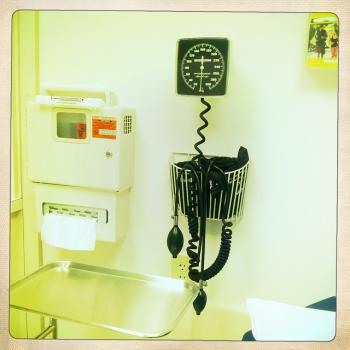When the two young women from the CCAC (Community Care Access Centre) appeared at my bedside the morning I was being discharged from the hospital I could tell they really wanted to help. The senior of the two was reading my chart as she introduced me to the woman she was training. They both smiled implausibly brightly.
"Sooo..." she said, as she squinted at the nursing notes. "You had an ileostomy before, so you're OK to manage that? But you need wound care?"
"Actually, I need both," I told her. "The nurses told me that I would get sent to a clinic for the ileostomy. So they just wrote down wound care."
"Well really if you're ambulatory we prefer everyone to go the clinic," she said.
"Well I'm not really ambulatory and I definitely can't drive and I know from experience that I'm not at all ambulatory immediately following wound care. Plus my ileostomy is still a surgical site so it's not really a matter of 'management' as much as wound care." I smiled encouragingly. "So I'm sure we can work this out so you can organize home care."
To their credit they both laughed with relief at my directness.
"I'm not sure how," she said. "But we will try to make this work."
Accessing care amid cuts
Their purported job was to assess me with a view to organizing my care at home but it quickly became clear that other factors were at play. I've written before about the refrain we have heard from governments about health care over the last two decades -- "People want to be treated in their homes. Give the people what they want" -- and the activist response -- "Home care is being used as a cover for hospital cuts. Of course we all want to be at home but we want to be well-cared for."
A few weeks later I was scrolling through my Facebook feed and came across a post by a fellow disability activist, Samantha Walsh, about her horrifying experience receiving wound care in a downtown Toronto CCAC clinic. She had been told that once she returned to work full time the clinic would provide a more flexible wound care option than the home care she had been receiving until then. Sam uses a wheelchair, so naturally asked whether the clinic was accessible and was assured by staff that it was. But when she arrived, the nurse providing her care told her that her wheelchair wasn't allowed in the room.
"You can walk though, right?" the nurse asked after announcing that she couldn't assist Sam in transferring from her chair to the examining table.
Sam managed to do so, and then took to Facebook asking if anyone else had encountered these issues. Her next couple of appointments were much better, leading her to wonder if the issue was more with the particular nurse than the clinic as a whole. After being glued to the comments thread on her posts, I sent a message asking if we could talk and Sam kindly agreed.
The first thing we discussed is the central dilemma of all patients: we don't want to complain too much because we want to get the wound healed. And the present trouble with home care and CCAC clinics is the same as the trouble with all types of care -- the fact that the people who try to care for us are constrained by infrastructure and budgets and bosses. And everyone is so isolated within the system that one hand rarely seems to have any sense at all of what the other hand might be doing.
Streamlining patients into clinics
So the day after my discharge, a very abrupt man was standing in my bedroom pointing a bottle of saline solution at me. This moment with this nurse definitely ranked in my top 10 most awkward health-care encounters of all time. I declined his assistance as I explained that the hospital nurses had shown me how to clean the wound myself, and then phoned the CCAC asking if perhaps they could send a woman to do intimate wound care in the future. On the phone, I had the exact same conversation I had in the hospital before discharge about whether I could go to a clinic or not and I repeated the same factors. The coordinator on the phone was a lot more circumspect than the ones at the hospital and didn't want to acknowledge the pressure she was under to streamline patients into their clinics.
"That's not exactly how I would put it," she said, before essentially confirming that this was the case. But she did thankfully manage to set up the rest of my care for the next six weeks to be performed by kind and skilled women in my bed at home.
I didn't know that the Ontario health-care system could still surprise me. But until this surgery I had no idea that the same concept that had justified replacing hospital care with CCACs was now sending patients to clinics. The complete opposite of the already suspect justification, "give the people what they want."
By eerie coincidence Sam and I have very similarly located wounds that are about equally complicated, if for slightly different reasons. She described the scene in the clinic: thin curtains between stretchers and a door that opens into a public hallway shared with other, non-medical offices.
"It was like a gymnasium," she told me. "It's not a good place to have your pants off."
I shuddered. Sam went on to describe an appointment where her wheelchair had been left in the communal area with her clothes on it. The nurse left to go to the main desk and Sam called after her, asking if she was coming back.
"Oh, you're done!" the nurse called. Not considering the fact that Sam would have to find a way to get to her wheelchair without pants.
I don't feel like this point can be emphasized enough: the argument for CCACs was to give people care in their homes because we don't like hospitals. And now they are trying to get us to leave our homes after being discharged from hospitals to be treated in clinics that seem even less equipped to give us what we want or need.
Fixes for an ailing system
Which brings me to Ontario Health Minister Eric Hoskins' Patients First Act. In the fantasy universe described in this Act, simply dismantling the CCACs which have now been widely exposed as corrupt will be enough to transform patient experiences. Never mind that they will in effect continue to run with equally little oversight under the purview of the equally problematic Local Health Integration Networks (LHINs). For a full analysis see the Ontario Health Coalition's discussion paper here.
Sam summed it up like this: "I feel like in some ways we're spending more money under the guise of not spending money."
The Auditor General's report on CCACs a year ago certainly reveals this to be the case with evidence of bloated executive salaries while the front lines are starved for resources. And while plenty of evidence points to the dangers of patients ending up back in hospitals and costing the system more when home care fails to manage their recoveries, there is little to no acknowledgement of the emotional and physical trauma patients endure while caught in badly coordinated systems of care.
In both Sam's and my hospital experiences we encountered more patients who were afraid of being discharged too soon. No one wants to be in hospital, obviously. But when we are discharged we need to know that we will be adequately treated and supported. Sam also asked me to make it clear that she had much better experiences with a different nurse at the same clinic and it's entirely possible that the inaccessibility issues were specific to this clinic. But I think we can all agree that Sam should never have been expected to go into battle during her surgical recovery for something as obvious and basic as keeping her wheelchair in the treatment room of a CCAC clinic.
And to give Sam the final word here: "we are not actually empowering people to heal -- we are creating a neoliberal environment that puts the onus of recovery on the sick person."
Julie Devaney is a health, patient and disability activist based in Toronto. Her rabble column, "Health Breakdown," is an accessible, jargon-free take on the politics behind current health-care stories. You can find her on Twitter: @juliedevaney
Image: Will Fisher/flickr



Comments
Do
Don't